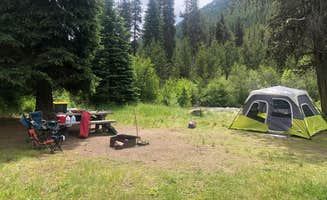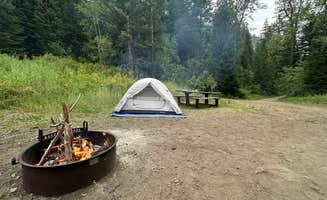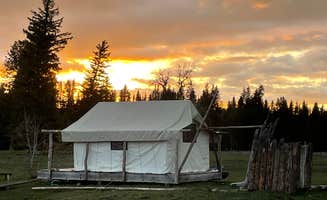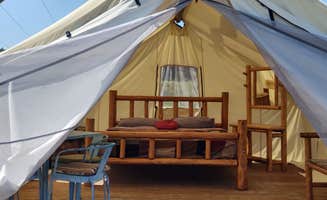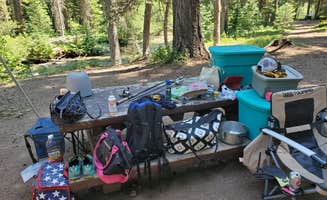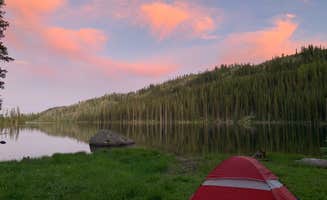Camping in Wallowa Whitman National Forest ranges across elevations from 3,000 to 9,000 feet, creating distinct microclimates that affect camping conditions throughout the season. The area includes over 2.3 million acres of diverse terrain, with the Eagle Cap Wilderness containing Oregon's largest concentration of high alpine lakes. Many campgrounds remain snow-covered until late June, with alpine lake areas typically accessible only from mid-July through September.
What to do
Hiking to Ice Lake: The trail to Ice Lake climbs approximately 3,700 feet over 9 miles, offering high-elevation backcountry camping at around 8,000 feet. A camper notes that "The water is no-joke cold. Fantastic nine-mile hike into the forest. Stayed two nights. Elevation is ~8,000 feet. Got altitude sickness on day two." Add-on hikes to nearby peaks require significant additional elevation gain but provide panoramic views.
River activities: The Lostine River corridor offers multiple access points for fishing and water play at smaller campgrounds. Sites at Walla Walla Forest Camp provide direct river access, with a camper stating: "Just 4 sites, 2 with great river access. We loved the view and how big and private our site was." This area features catch-and-release fishing for native trout.
Alpine gondola: For non-hiking access to mountain views, the Wallowa Lake Tramway operates daily from mid-May through mid-October (9 am to 4 pm), weather permitting. A visitor to Wallowa Lake State Park Campground mentioned: "We took the tram up and visited a mountain summit 3700 feet above our location at the campground. There were numerous hiking trails, and fishing was a popular pastime for many campers."
What campers like
Cold-water swimming: The glacier-fed rivers and lakes maintain cold temperatures even during summer heat. A camper at Hurricane Creek Campground observed: "The river is shallow in most places but right off this site it has a deep area where you can dip, the water is freezing even in late August, and there's a 3 foot jump down onto the bank."
Wildlife viewing: Early mornings provide the best wildlife viewing opportunities throughout the forest. According to one camper: "Saw two bucks together early in the morning grazing" at Hurricane Creek, while another noted: "Deer wandered through the campground and there are chipmunks."
Private campsites: Many smaller campgrounds offer significant space between sites. A visitor to Williamson Campground mentioned: "Sites were great. We had no issues getting an open site here the week of 4th of July. The river is a great backdrop and sound. Space for 1 tent easily…maybe a 2nd in some. Good trees for hammock."
Mineral hot springs: About an hour's drive from the main Wallowa area, Grande Hot Springs RV Resort provides natural hot spring soaking. A visitor described: "The soaking pools were amazing. They even had a twilight soak. Very peaceful and relaxing campground. Nature trail along the creek was cool. Saw huge bull frogs, tadpoles, and fish. Also saw mule deer."
What you should know
Limited services: Most forest service campgrounds operate without potable water or garbage service. At Irondyke Forest Camp, a camper noted: "The access road was narrow and in pretty rough shape, lots of horse trailers hauling livestock up and down the road. The road remained busy until late at night and during the weekend with other campers and day hikers."
Stream noise: Fast-flowing creeks create significant background noise at streamside sites. One camper described Hurricane Creek as "very loud," while another explained: "The fast-moving creek creates a soothing white noise that we found calming. The campsites are spaced quite far apart, some only large enough for a tent."
Insect preparation: Mosquitoes can be intense, particularly at sites further from moving water. A visitor to Walla Walla Forest Camp advised: "Our spot was tucked back a little way, which we liked. But was furthest from the water and swampy, which we didn't like. The other two spots are closer to the water, so you don't have to contend so much with misquitos. Just bring bug spray and check for ticks!"
Road conditions: Access roads to many campgrounds deteriorate significantly during and after wet weather. A visitor observed: "If you approach the campsite from the East, be prepared for a bumpy road. The road from the West (LaGrande) is much better even if it takes you a few miles out of the way."
Tips for camping with families
Kid-friendly locations: Wallowa Lake State Park offers the most amenities for families with small children. A visitor shared: "Large, pretty open campground. Right on the lake, great for family camping. Lots of hiking nearby!" Another mentioned: "There are go carts and mini golf nearby for families, and the gondola provides gorgeous views."
Dispersed camping safety: Families should exercise caution when camping near fast-moving streams. One camper at Hurricane Creek warned: "My one caution would be that if you have dogs keep them on a leash because if they were to get in the creek that would be all she wrote. That creek is appropriately named as it really moves."
Horse-friendly options: For families interested in equestrian activities, Two Pan provides specialized facilities: "The camp has four spots for camping with picnic tables, fire pit, tie ups for horses and hay holders. There was some hay left over that attracted a deer very close to us as we camped here at night."
Off-season considerations: Families seeking more solitude might consider visiting during shoulder seasons. A late-autumn visitor noted: "We arrived in late November, when it was cold, snowy, and practically empty. But the campground and all of its facilities were open, and the camp host was extremely friendly and helpful!"
Tips from RVers
Site selection strategy: RVers should research site dimensions carefully before arrival. At Park At The River, a camper advised: "This RV park is on the south side of Wallowa Lake nestled on the river that feeds the lake. They have 49 full hookup sites and they definitely pack them in there. We opted for a river site which is dry camping but much quieter and a bit more dispersed."
Leveling requirements: Many forest campgrounds have uneven sites requiring leveling equipment. One RVer shared: "Spent one night in that spot then took another closer to the river for the second night where I had to use my leveling blocks. But so worth it."
Generator considerations: Generator noise can impact the wilderness experience. A camper noted: "The dry camping spots by the river are great until the neighbors run a generator all day long."
Dump station limitations: Some facilities have limited capacity. A visitor cautioned: "They ask that you don't offload a full black/grey tank at your site, as the septic system can't handle it... in my experience, the dump site may not be able to handle it either. We were after another camper, and it began to overflow as we finished emptying our grey... neither having been completely full."



